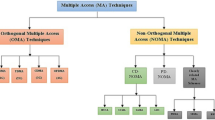Conclusion
NOMA assisted NGMA has been envisioned in the recently published IMT-2030 Framework. This perspective has outlined three important features of NOMA assisted NGMA, namely multi-domain utilization, multi-mode compatibility, and multi-dimensional optimality, where important directions for future research into the design of NOMA assisted NGMA have also been discussed.
Similar content being viewed by others
References
You X H, Wang C X, Huang J, et al. Towards 6G wireless communication networks: vision, enabling technologies, and new paradigm shifts. Sci China Inf Sci, 2021, 64: 110301
ITU. Framework and Overall Objectives of the Future Development of IMT for 2030 and Beyond. Technical Report ITU-R M.2160-0, 2023
Islam S M R, Avazov N, Dobre O A, et al. Power-domain non-orthogonal multiple access (NOMA) in 5G systems: potentials and challenges. IEEE Commun Surv Tut, 2017, 19: 721–742
Ding Z G, R Schober, Poor H V. Design of downlink hybrid NOMA transmission. 2024. ArXiv:2401.16965
Zhu J, Wan Z, Dai L, et al. Electromagnetic information theory: fundamentals, modeling, applications, and open problems. IEEE Wireless Commun, 2024. doi: https://doi.org/10.1109/MWC.019.2200602
Ding Z. Resolution of near-field beamforming and its impact on NOMA. IEEE Wireless Commun Lett, 2024, 13: 456–460
Sutton R S, Barto A G. Reinforcement Learning: An Introduction. Cambridge: MIT Press, 1998
Acknowledgements
Zhiguo DING was supported by UK EP-SRC (Grant Nos. EP/W034522/1, H2020-MSCA-RISE-2020, 101006411). Robert SCHOBER was supported by German Research Foundation (DFG) under Project SFB 1483 (Project-ID 442419336 Empkins) and BMBF under the Program of “Souveran. Digital. Vernetzt.” Joint Project 6G-RIC (Project-ID 16KISK023). Pingzhi FAN was supported by National Natural Science Foundation of China (Grant No. 62020106001). H. Vincent POOR was supported by U.S National Science Foundation (Grant Nos. CNS-2128448, ECCS-2335876).
Author information
Authors and Affiliations
Corresponding author
Rights and permissions
About this article
Cite this article
Ding, Z., Schober, R., Fan, P. et al. Next generation multiple access for IMT towards 2030 and beyond. Sci. China Inf. Sci. 67, 166301 (2024). https://doi.org/10.1007/s11432-024-4014-x
Received:
Revised:
Accepted:
Published:
DOI: https://doi.org/10.1007/s11432-024-4014-x




